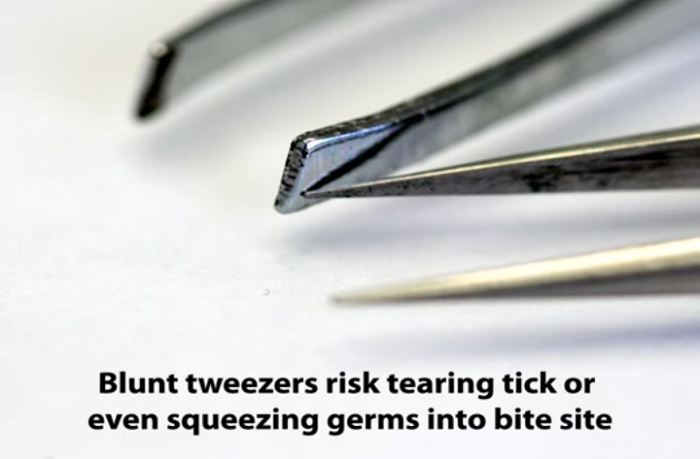
Ticks are one of the most annoying and scary drawbacks to taking your dog outdoors. In some places, like Pennsylvania, they are so bad dogs come back from a fifteen minute walk with dozens of them.
And it’s no laughing matter. There are many types of ticks and they carry many diseases, not just the dreaded Lyme disease.
Other diseases include:
- Babesiosis
- Anaplasmosis
- Rocky Mountain Spotted Fever
- Tularemia
Obviously, you don’t want these things hanging around on your dog but they can be really hard to get out safely. And don’t think they will just leave on their own.
According to Tickencounter.org, “Generally if undisturbed, larvae remain attached and feeding for about 3 days, nymphs for 3-4 days, and adult females for 7-10 days. Deer ticks feed a day or so faster than Lone Star ticks and American dog ticks.”
One of the biggest issues is that everyone has conflicting and unclear advice when it comes to tick removal.
For example, Tickencournter.org says, “Don’t worry if the head stays in, just disinfect the area with rubbing alcohol.”
On the other hand, LymeNetEurope.org says the opposite (and gives a good reason for it as well): “If the head of the tick remains in place, then the salivary glands may still be there, with possibly pathogens. Then there is still a potential risk of contamination! Try to remove the tick’s head as well and if it fails, consult a doctor.”
They do mention that if part or all of the hypostome (the barbed parts of the tick that go into the skin) is what stays in, there is probably no risk for continued contamination.
What about all those old home remedies?
For decades people have used all sorts of creative ways to removes ticks, including fire, grease, soap and water, etc. LymeNetEurope.org says doing anything to “irritate” tick to get it to release on its own is a BAD IDEA.
Why?
“All methods that involve irritating the tick, potentially increase the chance that the tick produces extra saliva or vomits its stomach contents, which could contain pathogens.” (LymeNetEurope.org).
Another popular way to remove a tick is to “twist” it off. There is even a “Tick Twister” tick remover.

The idea behind rotating the tick came from the misconception that ticks screw themselves into the skin and so you can remove by “unscrewing” them. However, ticks don’t do this. They do attach their hypostome, and the barbs can get stuck in the skin if you rotate the tick, but not always.
So What IS The Best Way?
The first thing to realize is that marketing is marketing and business is business. People selling tick removal kits are going to tell you theirs is the “safest, best, most effective, etc.” But that doesn’t mean it’s true.
LymeNetEurope.org says this:
“Scientific research shows that tick removal with a fine point tweezers is one of the best methods, and in general the recommended method. Such a tweezers is easy to handle and the chance of squeezing the tick is small.” (link to research here.)

They make an important distinction here – be sure to use fine point tweezers and not the normal broad, flat tip tweezers because with the flat ones you run the risk of squeezing the tick (which could release more pathogens) and/or you could break the tick apart.
Here is a quick and simply video by TickEncounter Resource Center showing how to safely remove a tick:
Based on research, this is the best way to remove a tick.
Once the tick is out:
- You need to document the date, where the tick was found on the body, length of time on the body and how you removed it.
- You want to check the site for signs of infection and take your dog to the vet if you notice anything strange.
- Do not crush the tick once removed! It can still release pathogens! Instead, put it in an airtight container and throw away. If possible, keep the tick, so it can be tested for possible pathogens if necessary.
You can also help with research by submitting an image of your tick on the TickEncounter Resource Center’s TickSpotter page.
About the Author
Based in Wilsonville, Ore., animal lover Kristina N. Lotz is a Certified Professional Dog Trainer – Knowledge Assessed (CPDT-KA) and a member of the Dog Writers Association of America. She is the founder of A Fairytail House. In her spare time, she trains and competes in a variety of performance events with her Shetland Sheepdogs and caters to her two rescue kitties. She smartly married a Veterinary Technician, who helps keep the fur kids happy and healthy, and provides a quick resource for articles.
